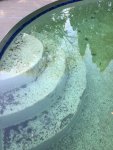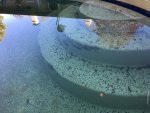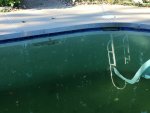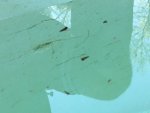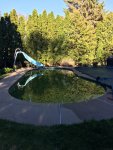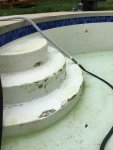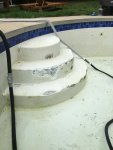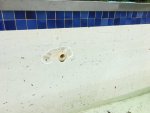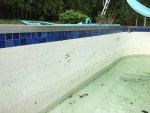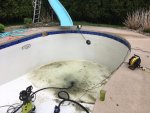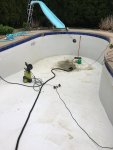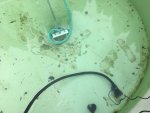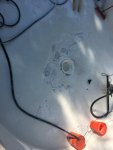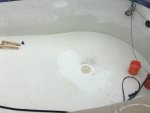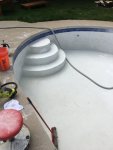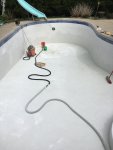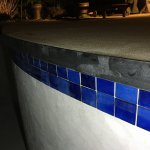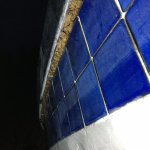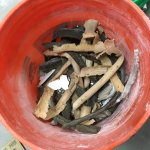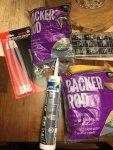Hello everyone, over the last couple years we have noticed more and more algae sticking to the floor and walls of our pool due to a finish that is rough. The $10k quotes we have recieved for a chip out and plaster are more than we want to spend at this time. I have found a few videos of people sanding down their pools with diamond sanding pads with really good results.
We plan on patching the edge of our stairs, some spots on the floor in the deep end, and a couple spots on the walls. I haven't done much research on which product to use except that I should clean the areas off with a power washer, use a bonding agent, patch the spot, then use a wet sponge to finish. Any suggestions on what bond/patch products work best would be nice. We have a white pool and I do have concerns of color matching.
For sanding I have decided to go with a 5" polisher and I am leaning towards a wet polisher, but I might get a dust hood to see if the process goes quicker or if the finish looks better using dry polishing. Again, any suggestions in this area would be helpful.
I have found that sanding pads come in various price ranges and don't really know what to expect in terms of how many pads I will go through. There are some pads that are sold in 50, 70, and 120 grit specifically for pool plaster that show 1500-2000 sq ft coverage for the coarse grits and up to 3000 sq ft for the finer grits. There are also pads made for quartz/concete/marble/etc that show 150 sq ft coverage, but I know the plaster is certainly not as hard as those rocks. My pool has an estimated 1000 sq ft of plaster. My original plan at this point is to start with 50 grit and come back with either 100 or 150 grit to smooth it out.
I will be posting pictures of the before, during, after in hopes that other members can learn from my successes and hopefully not too many mistakes.
Pool Info:
~16x32 pool 3.5' in shallow, 6' in deep end
~1000 sqft of white plaster
Unpurchased material list:
Polisher - Stadea SWP101K or SWP108K
Wet Diamond Pads - Stadea PPW192D (50, 100 or 150 grit)
Patch Bonding Agent - Not found
Patch Material - Not found
Boots, submersible pump,etc
Thanks to onBalance for initial info!
I have also had some issues with my pool light which I have narrowed down to a possible fixture problem so we will be swapping our 120V incandescent light to a 12V LED light.
We plan on patching the edge of our stairs, some spots on the floor in the deep end, and a couple spots on the walls. I haven't done much research on which product to use except that I should clean the areas off with a power washer, use a bonding agent, patch the spot, then use a wet sponge to finish. Any suggestions on what bond/patch products work best would be nice. We have a white pool and I do have concerns of color matching.
For sanding I have decided to go with a 5" polisher and I am leaning towards a wet polisher, but I might get a dust hood to see if the process goes quicker or if the finish looks better using dry polishing. Again, any suggestions in this area would be helpful.
I have found that sanding pads come in various price ranges and don't really know what to expect in terms of how many pads I will go through. There are some pads that are sold in 50, 70, and 120 grit specifically for pool plaster that show 1500-2000 sq ft coverage for the coarse grits and up to 3000 sq ft for the finer grits. There are also pads made for quartz/concete/marble/etc that show 150 sq ft coverage, but I know the plaster is certainly not as hard as those rocks. My pool has an estimated 1000 sq ft of plaster. My original plan at this point is to start with 50 grit and come back with either 100 or 150 grit to smooth it out.
I will be posting pictures of the before, during, after in hopes that other members can learn from my successes and hopefully not too many mistakes.
Pool Info:
~16x32 pool 3.5' in shallow, 6' in deep end
~1000 sqft of white plaster
Unpurchased material list:
Polisher - Stadea SWP101K or SWP108K
Wet Diamond Pads - Stadea PPW192D (50, 100 or 150 grit)
Patch Bonding Agent - Not found
Patch Material - Not found
Boots, submersible pump,etc
Thanks to onBalance for initial info!
I have also had some issues with my pool light which I have narrowed down to a possible fixture problem so we will be swapping our 120V incandescent light to a 12V LED light.
Last edited:


